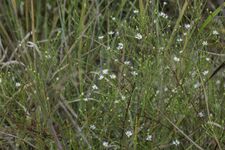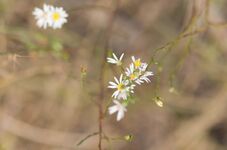Biology:Symphyotrichum depauperatum
| Symphyotrichum depauperatum | |
|---|---|

| |
| S. depauperatum from the serpentine grassland demonstration area in Nottingham, Pennsylvania. | |
| Scientific classification | |
| Kingdom: | Plantae |
| Clade: | Tracheophytes |
| Clade: | Angiosperms |
| Clade: | Eudicots |
| Clade: | Asterids |
| Order: | Asterales |
| Family: | Asteraceae |
| Genus: | Symphyotrichum |
| Section: | Symphyotrichum sect. Symphyotrichum |
| Species: | S. depauperatum
|
| Binomial name | |
| Symphyotrichum depauperatum (Fernald) G.L.Nesom
| |

| |
| Endemic distribution[2][1] | |
| Synonyms[3] | |
|
Basionym
Alphabetical list
| |
Symphyotrichum depauperatum (formerly Aster depauperatus), commonly known as serpentine aster or starved aster,[4][5] is a rare species in the family Asteraceae adapted to serpentine barrens, an ecosystem with a high concentration of toxic metals in the soil. It has been found in Pennsylvania, Maryland, and on some diabase glades in North Carolina. It grows to 50 centimeters (1 3⁄4 feet) and has white ray florets surrounding a center of yellow disk florets.
Description
Symphyotrichum depauperatum is a perennial, herbaceous plant that may reach up to 50 centimeters (1 3⁄4 feet) tall, with 1–3 stems. The leaves are narrow and generally 2–4 centimeters (3⁄4–1 1⁄2 inches) long. The plant produces numerous flower heads in branched arrays, each head with 7–14 white or, rarely, pink ray florets surrounding 7–17 yellow disk florets.[4]
Taxonomy
Within the genus Symphyotrichum, S. depauperatum has been classified in subgenus Symphyotrichum section Symphyotrichum subsection Porteriani.[6] Its full name with author citation is Symphyotrichum depauperatum (Fernald) G.L.Nesom.[3] It was first described by American botanist Merritt Lyndon Fernald in 1908 as Aster depauperatus.[7]
Distribution and habitat
S. depauperatum is adapted to serpentine barrens, an ecosystem with a high concentration of toxic metals in the soil. It has been found in Baltimore[2] and Cecil Counties, Maryland;[1] Granville County, North Carolina;[2] and, Chester, Delaware, and Lancaster Counties, Pennsylvania.[1]
Serpentine aster has been called a "flagship species" of the unique serpentine ecosystem and was once thought to be endemic to these barrens,[8] but it also has been found to occur in a disjoint population on diabase glades in Granville County, North Carolina.[9]
Conservation
Symphyotrichum depauperatum is classified by the state of Pennsylvania as a threatened species because its range is restricted to a few limited areas, and the majority of its populations occur on sites threatened by quarrying, housing development, and industrial development.[10]
(As of August 2022), NatureServe listed it as Globally Imperiled (G2); Critically Imperiled (S1) in Maryland and North Carolina; and, Imperiled (S2) in Pennsylvania. NatureServe's most recent review of S. depauperatum's global status was 3 October 1997.[1]
Citations
- ↑ 1.0 1.1 1.2 1.3 1.4 NatureServe (2022).
- ↑ 2.0 2.1 2.2 Gustafson & Latham (2005), p. 1447.
- ↑ 3.0 3.1 POWO (2021).
- ↑ 4.0 4.1 Brouillet et al. (2006).
- ↑ USDA, NRCS (2014).
- ↑ Nesom (1994), p. 270.
- ↑ IPNI (2021).
- ↑ Gustafson & Latham (2005), p. 1445.
- ↑ Gustafson & Latham (2005), pp. 1449–1450.
- ↑ Pennsylvania DCNR (n.d.).
References
- Flora of North America Editorial Committee, ed. (2006), "Symphyotrichum depauperatum", Flora of North America North of Mexico (FNA), 20, New York and Oxford, http://www.efloras.org/florataxon.aspx?flora_id=1&taxon_id=250067637, retrieved 3 July 2021
- Gustafson, D.J.; Latham, R.E. (June 2005). "Is the serpentine aster, Symphyotrichum depauperatum (Fern.) Nesom, a valid species and actually endemic to eastern serpentine barrens?" (in en). Biodiversity and Conservation 14 (6). doi:10.1007/s10531-004-9670-x. https://www.researchgate.net/profile/Danny-Gustafson/publication/225237954_Is_the_serpentine_aster_Symphyotrichum_depauperatum_Fern_Nesom_a_valid_species_and_actually_endemic_to_eastern_serpentine_barrens/links/0fcfd509c66179dae9000000/Is-the-serpentine-aster-Symphyotrichum-depauperatum-Fern-Nesom-a-valid-species-and-actually-endemic-to-eastern-serpentine-barrens.pdf. Retrieved 5 September 2021.
- IPNI. "Aster depauperatus Fernald, Rhodora 10: 94 (1908)". International Plant Names Index (IPNI). Royal Botanic Gardens, Kew. https://www.ipni.org/n/23304-2.
- "Symphyotrichum depauperatum Serpentine Aster" (in en). Arlington, Virginia. 5 August 2022. https://explorer.natureserve.org/Taxon/ELEMENT_GLOBAL.2.159156/.
- "Review of the taxonomy of Aster sensu lato (Asteraceae: Astereae), emphasizing the New World species" (in en). Phytologia 77 (3): 141–297. September 1994. 31 January 1995. ISSN 0031-9430. https://www.biodiversitylibrary.org/page/12959940/. Retrieved 23 August 2021.
- "Serpentine Aster Profile" (in en). Pennsylvania Department of Conservation, Natural Resources Wildlife Resource Conservation Fund. n.d.. http://www.dcnr.state.pa.us/wrcp/aster.aspx.
- POWO (2021). "Symphyotrichum depauperatum (Fernald) G.L.Nesom" (in en). Royal Botanic Gardens, Kew. http://www.plantsoftheworldonline.org/taxon/981799-2.
- ((USDA, NRCS)) (2014). "Symphyotrichum depauperatum". Natural Resources Conservation Service PLANTS Database. USDA. https://plants.usda.gov/core/profile?symbol=SYDE2.
External links
Information about Symphyotrichum depauperatum also can be seen at the following pages:
- Ladybird Johnson Wildflower Center (wildflower.org)
- University of Waterloo Astereae Lab
- Vascular Plants of North Carolina
- Pennsylvania Natural Heritage Program
- Maryland Biodiversity Project
- Symphyotrichum depauperatum as Pennsylvania Threatened in the Pennsylvania Code
Wikidata ☰ {{{from}}} entry
 |






